 Crime
Crime  Crime
Crime  Technology
Technology 10 Hilariously Over-Engineered Solutions to Simple Problems
 Miscellaneous
Miscellaneous 10 Ironic News Stories Straight out of an Alanis Morissette Song
 Politics
Politics 10 Lesser-Known Far-Right Groups of the 21st Century
 History
History Ten Revealing Facts about Daily Domestic Life in the Old West
 Weird Stuff
Weird Stuff 10 Everyday Products Surprisingly Made by Inmates
 Movies and TV
Movies and TV 10 Actors Dragged out of Retirement for One Key Role
 Creepy
Creepy 10 Lesser-Known Shapeshifter Legends from Around the World
 Animals
Animals 10 Amazing Animal Tales from the Ancient World
 Gaming
Gaming 10 Game Characters Everyone Hated Playing
 Crime
Crime 10 Terrifying Serial Killers from Centuries Ago
 Technology
Technology 10 Hilariously Over-Engineered Solutions to Simple Problems
 Miscellaneous
Miscellaneous 10 Ironic News Stories Straight out of an Alanis Morissette Song
Who's Behind Listverse?

Jamie Frater
Head Editor
Jamie founded Listverse due to an insatiable desire to share fascinating, obscure, and bizarre facts. He has been a guest speaker on numerous national radio and television stations and is a five time published author.
More About Us Politics
Politics 10 Lesser-Known Far-Right Groups of the 21st Century
 History
History Ten Revealing Facts about Daily Domestic Life in the Old West
 Weird Stuff
Weird Stuff 10 Everyday Products Surprisingly Made by Inmates
 Movies and TV
Movies and TV 10 Actors Dragged out of Retirement for One Key Role
 Creepy
Creepy 10 Lesser-Known Shapeshifter Legends from Around the World
 Animals
Animals 10 Amazing Animal Tales from the Ancient World
 Gaming
Gaming 10 Game Characters Everyone Hated Playing
Top 10 Mysterious Nautical Legends and Superstitions
Something about life at sea seems to make people a little superstitious. It could be because sailors live at the mercy of the elements and follow any legend, trick, or myth that they feel might give them some extra protection. Maybe it’s because sailing is one of the world’s oldest trades. Or maybe it’s just the kind of person that life at sea attracts. Whatever the reason might be, many fascinating nautical stories have endured for centuries.
Related: 10 Times Old Superstitions Became Deadly
10 Jonahs
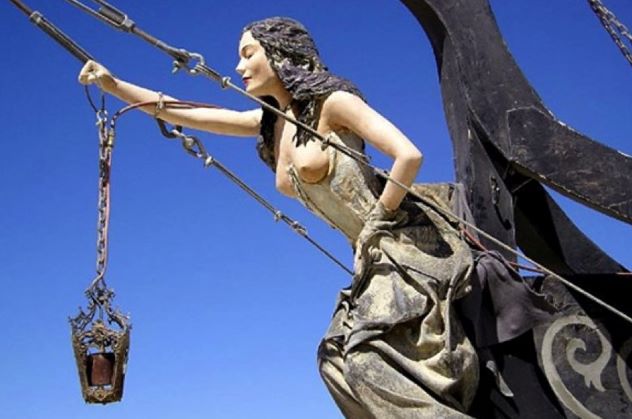
If you think that life at sea was open to almost anyone, you may have to think again. Sailors were pretty picky with who they allowed on board. Anyone considered bad luck could be called a “Jonah,” in reference to the biblical prophet who was swallowed by a giant fish and spit back out.
Women, redheads, priests, debtors, and murderers were all considered bad luck on a ship, although not allowing murderers was probably a good call. Sailors often had a strong superstition that women on a ship could distract the crew and anger the sea-gods. At least one time in the Middle Ages, a crew threw dozens of female passengers overboard when they entered a storm, although most of the men ended up dying in the wreck anyway.
But if a pregnant woman did make it onto a ship, a child born at sea would be considered good luck. Strangely (and conveniently for lonely sea dogs), naked women were also considered good luck. This is why many ships have carvings of nude women on the front of the boat as figureheads.
Priests were associated with funerals, which nervous sailors didn’t appreciate being reminded about. If you ran into a devilish redhead before you boarded a ship, you could potentially avoid their bad luck if you spoke to them before they spoke to you. [1]
9 Klabautermann

The idea of Klabautermann is a rare positive sailor legend. A Klabautermann is a helpful water sprite from Northern European folklore that takes the appearance of tiny sailors in yellow clothes. According to legend, these helpful little creatures could help fix the ship, rescue sailors thrown overboard, and play music. They are often depicted carrying a pipe and hammer, and the sound of their rumbling voices or the pounding of their tools could often be heard by sailors as the creatures explored the ship and fixed leaks.
Images of Klabautermann were often carved into ships as a good luck charm. If a sailor did catch a glimpse of one, it could mean that their ship was doomed to sink, but the Klabautermann could also be warning the crew of the danger. Occasionally, a Klabautermann would move items around or play tricks on sailors, but they were generally considered helpful creatures. If you were an especially nice captain, Klabautermann might even follow you from one ship to another in order to help and protect you.[2]
8 No Bananas

One of the strangest enduring pieces of nautical lore is the taboo of the banana. The fear of bananas on ships dates back to the 1700s in the Caribbean. The most likely origin theory is probably that banana ships had to travel very fast to prevent spoiling, which was not conducive to fishing or safety. Bananas may float to the top of shipwrecks, leading observers to associate the fruit with the tragedy. Sailors were also at risk of slipping on the peels and injuring themselves.
The banana myth might actually have some scientific backing. It has been theorized that the ripening fruit could have released ethylene gas, which may have sickened the crew and damaged the wooden hulls of the ships. Poisonous spiders and snakes have also been known to hitch a ride on tropical fruit. This legend has lasted into the modern era.
One fisherman from Florida told the news that he checks arriving passengers on his ship for Banana Republic clothes, Banana Boat sunscreen, and even Fruit of the Loom undergarments, despite the fact that Fruit of the Loom’s logo doesn’t even contain a banana. Another captain recounted an incident in 2001 when another fisherman slashed out the Banana Republic logo of a man’s t-shirt. Maybe consider avoiding anything banana-related the next time you book a fishing expedition, just to be safe.[3]
7 Davy Jones and His Locker
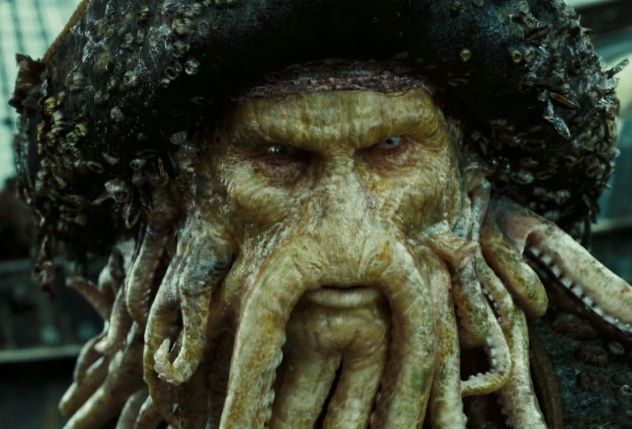
Davy Jones’s locker is generally a euphemism for the bottom of the sea, where shipwrecks and drowned sailors could be sent if something went horribly wrong. In one early story, Jones was described as having devil horns, a tail, huge round eyes, and multiple rows of teeth, similar to a shark. He also breathed blue smoke and would appear in the rigging of ships before a storm or a shipwreck.
The name of the devil, “Davy Jones,” could come from the combination of two religious characters. Saint David was the patron saint of Wales, and Welsh sailors often called on him to protect him at sea. The last name “Jones” is likely tied to the prophet Jonah. There was a real British pirate named David Jones who terrorized the Indian Ocean in the 1630s, but he was not well-known, and there’s likely no connection.
Another possible origin is a pub owner in London who would allegedly get sailors drunk, trap them in a locker, and then sell them as slaves. According to one story, the pub owner also stole a ship and became a pirate who captured crews, decapitated most of them, and then imprisoned the rest on the ships before sinking them.
However, Davy Jones isn’t always bad in nautical mythology. A common naval ceremony is still celebrated today when a sailor first passes over the equator—called “crossing the line”—and Davy Jones is often a character who assists King Neptune during the party. [4]
6 Mother Carey
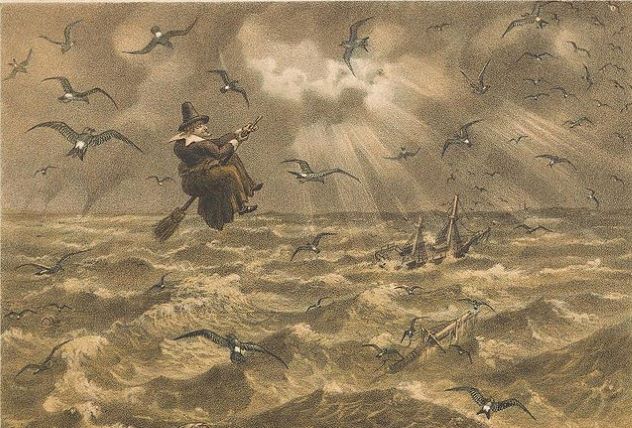
Mother Carey is not someone any seaman wanted to anger. Her legend originated in the 18th and 19th centuries and described her as a sea goddess or witch. In some tellings, she is married to Davy Jones (Source 14). Storm petrels, a type of bird, are often believed to be the souls of dead sailors and are heavily associated with her. They are sometimes called Mother Carey’s geese.
In certain stories, Mother Carey may also have the power to call retired sailors back to life at sea and could have the powers of a siren, using her powerful voice to lure men off ships to their watery graves. However, in almost all stories, Mother Carey is an evil character who can cause storms and shipwrecks, sending more souls to her husband’s locker.
It’s been theorized that her name comes from the expression “mater cara” or “precious mother,” which scared European sailors would call out when they encountered a dangerous situation at sea.[5] In some versions of her legend, Mother Carey lives on an iceberg in the northern seas and combs her hair with the bones of the dead.
5 Selkies
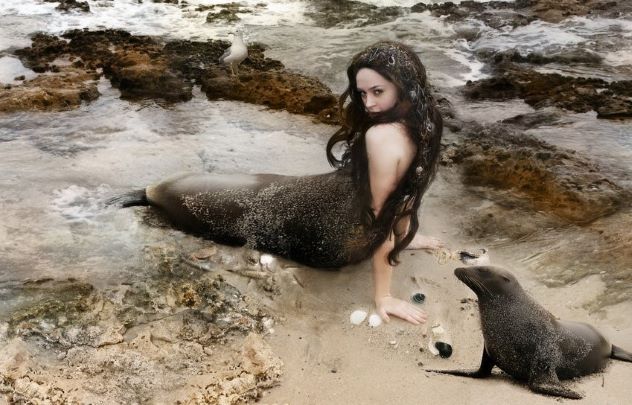
Staring out into the unknown depths of the sea, it made sense that many nautical legends involved speculation over what mysterious creatures might live beneath the waves. Selkies are mythical creatures common in Celtic and Norse nautical legend. They are ocean-dwelling beings that can shapeshift between the form of a seal and the form of a human.
Like mermaids, stories about them are often romantic, with sailors stealing the selkies’ seal skin to prevent them from turning back into seals so that the men could keep them as their wives. Unfortunately, the marriages often ended sadly, with the selkies either living as humans who long to return to their families and lives in the ocean or with the selkies finding their seal skin and abandoning their human husbands and children to return to the sea.
Most selkie stories are about female selkies, but there are also stories about handsome male selkies romancing lonely fishermen’s wives. Some descriptions of the creatures state that selkies were once fully human but became cursed after committing sins. Others state that selkies are actually fallen angels. Children born with webbed feet or toes were often seen as the children of a selkie and human. There is significant overlap in the myth of the selkie, mermaid, siren, and even the shape-shifting swan bride popular in European mythology.[6]
4 The Flying Dutchman
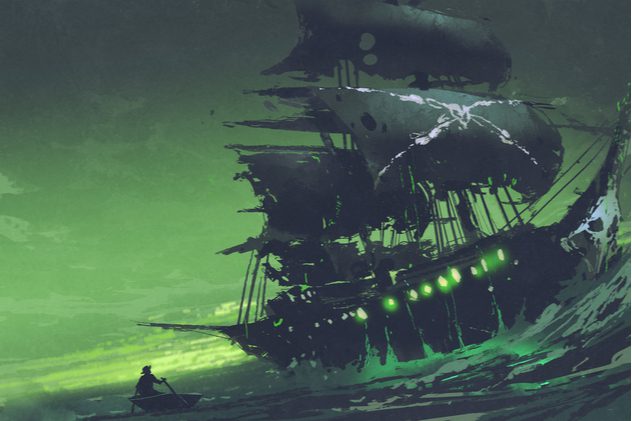
One of the most well-known nautical legends is the ghost ship The Flying Dutchman. The Dutchman is a mysterious ship with a ghostly glow that sailors have reported spotting for hundreds of years and is usually considered an omen of doom. The legend likely originated in the 17th or 18th century. The backstory most commonly involves a disappearing ship captained by a crew doomed to never touch land, wandering the seas forever as punishment for some horrible deed.
One of the very first written accounts of the legend in 1790 describes a Dutch captain attempting to sail around the Cape of Good Hope through a major storm. The crew tried to convince the captain to turn around, but he swore he would keep sailing to shore even if it took him until the end of time. The devil heard this promise and cursed the captain, whose only hope was to find a woman who truly loved him.
Some versions of the story name the real East India Company captain Bernard Fokke as the Dutchman. His sailing trips were so fast that jealous rivals often said he must have made a deal with the devil. Whatever the true origins are, reports of the ship carried on through the 20th century, including a first-hand report from the future King George V. Scientists have speculated that reports of the Dutchman are likely cases of the Fata Morgana mirage, which can make the ghostly image of a ship appear on the horizon.[7]
3 The Chaleur Phantom
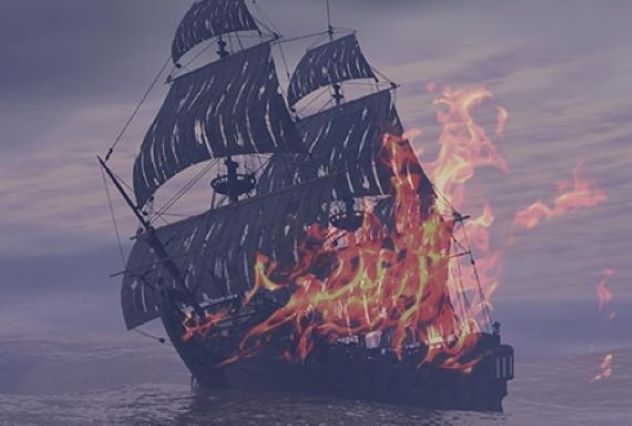
A similar case to the Dutchman is the Fireship of Baie des Chaleurs or the Chaleur phantom. This type of ghostly light is often spotted near New Brunswick, Canada, taking the form of a tall sailing ship on fire, often seen right before a storm.
One origin story tells of a woman killed by pirates in the area, who then cursed them, saying, “For as long as the world is, may you burn on the bay.” Another tale tells of a Portuguese sea captain who kidnapped the native Mi’kmaq people of the area as slaves in 1501, and the Mi’kmaq killed the captain as revenge. When the captain’s brother came to look for him, the Mi’kmaq set his ship on fire. As their ship burned, the men jumped into the sea and promised to haunt the bay for 1,000 years.
Another telling says one crew was afraid of a storm and murdered a man they believed was bad luck. The man’s vengeful spirit lit their ship on fire, and it has never gone out. Some scientists believe natural gas from underwater or floating marsh gas may cause the flash of light that locals believe is the haunting Chaleur Phantom.[8]
2 St. Elmo’s Fire
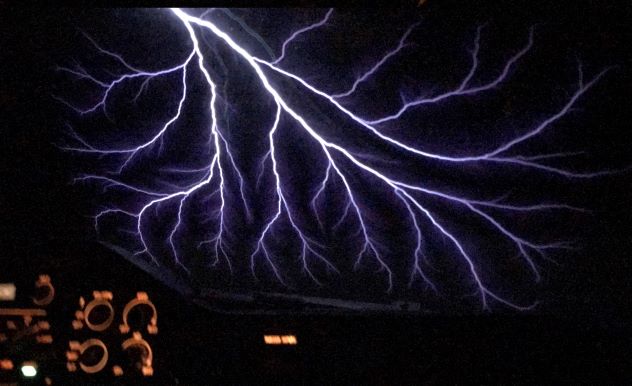
There is one kind of flashing light that is considered good luck by sailors. St. Elmo’s fire is a glowing light created on the masts of ships or other sharp objects like church spires, airplanes, chimneys, or even the horns of bulls and blades of grass. It usually takes on a fizzing, blue-violet color caused by strong electrical fields in the air, which can often be created during a lightning storm.
The phenomenon has been described throughout history, including reports from Charles Darwin, Ferdinand Magellan, Julius Caesar, Benjamin Franklin, and Nikola Tesla. Sailors believed this light was a good omen because it showed that St. Elmo—the patron saint of sailors—was traveling with them.
St. Elmo was originally known as Erasmus of Formia, and according to legend, he continued to preach even when a lightning bolt struck the ground right next to him. This led to the connection between St. Elmo and protection from storms, making him a good friend for a sailor to have. He’s also the patron saint of intestinal disease, cramps, colic, cattle, and labor pains[9]
1 Tattoos
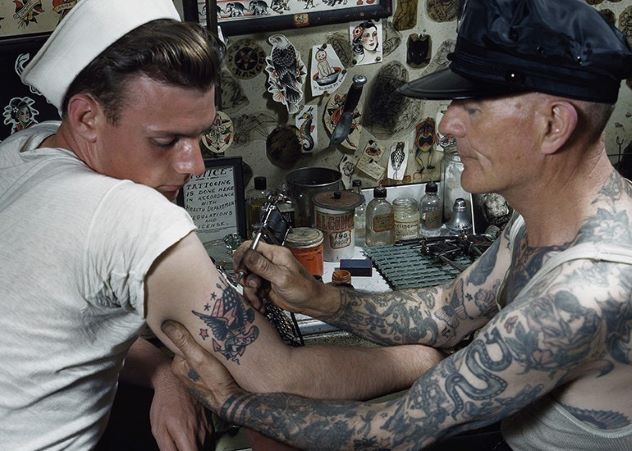
Tattoos have been a major part of nautical culture for centuries, but they’re often more than just body art for sailors. The first sailor tattoos likely originated when explorer James Cook arrived in the South Pacific during the 1700s, and his crew decided to get Maori tattoos as souvenirs from the journey.
In the early 1900s, many men got tattoos of naked women in hopes it would prevent them from being drafted into the Navy, but the problem was easily solved by having clothes added on top of the image. Norman Collins, also known as Sailor Jerry, helped popularize the classic style of American Navy tattoos from his shop in Hawaii during the mid-1900s.
Certain symbols and phrases are thought to contain protective powers. If a sailor was thrown overboard, tattoos of farm animals like pigs and chickens were thought to trick God into believing that a land animal had been lost at sea and needed to be brought back to land. This was also popularized because farm animals were often the only survivors of shipwrecks when their wooden crates floated.
A tattoo of the phrase “Hold Fast” on a sailor’s knuckles was believed to prevent them from falling off the ship’s rigging. A compass or north star was believed to help seamen find their way home. Some tattoos, including swallows, anchors, dragons, and turtles, were used to celebrate sailors’ achievements, like crossing the equator or the international dateline. [10]







